The data is comforting. As expected, with the arrival of the beautiful days the epidemic curve of the new cases of Covid-19 tends to fade. Above all, the commitment to health facilities is viewed with greater serenity, given that hospitalizations are drastically and progressively decreasing, both in normal hospitalization and in intensive care. But this unfortunately does not mean that the pandemic is over.
What is causing concern is the information coming from various countries, from South Africa to the Protogallo, where we are witnessing a growth in cases. Under the magnifying glass of science is there subvariant of Sars-CoV-2 Ba 5, which is also carefully monitored by us. Every day, in practice, there is a progressive increase in cases of infection linked to this viral strain. This is why we cannot let our guard down. And it is necessary to continue to be vigilant, paying attention to behavior, since Omicron 5 (or variant BA.5) also appears to be very contagiousperhaps even more than the variants that preceded it.
The variant is making its way
Without going too far, even in Italy, according to the most recent observations, we are witnessing a progressive increase (obviously in percentage terms) in cases of infection linked to Omicron 5 which is gradually taking the place of those who preceded it. In short, it is a viral strain that could “invade” in invisible terms the panorama of Covid-19, assuming a leading role among the different viral subtypes. Explaining why this is happening is certainly not easy. However, there are some elements that must be taken into consideration, as is done by experts.
First of all, according to what is known up to now, on the evolutionary front Omicron 5 is particularly “competitive” with respect to the circulating variants and therefore can tend to take up space especially with respect to the other types of Omicron circulating. Moreover Omicron 5 is also more transmissible and therefore potentially more contagious, with greater ease of “taking root” in the human organism.
This aspect would be linked to the mutations that characterize the latter variant: there would be two invisible “variations” in the genetic heritage of the virus that can make engraftment to human cells easier and more effective. Still in terms of Omicron 5 specific mutations, there is another aspect of concern.
A specific mutation present in the genetic makeup of Omicron 5 could be at the origin of significant changes in the structure of the protein that the virus uses to adhere to human cells. In this way, the possibility of causing infections by Omicron 5 would be higher and thus explains the greater diffusibility of the infection caused by this sub-variant.
How much does the presence of Omicron 5 and its mutations affect the response to antibodies, whether they are induced by previous infections or by the complete vaccination course? It is still not possible to say with certainty in terms of quantity, but according to what various experts believe there could be a greater possibility of “escape” from the antibody response compared to the previous variants of Omicron that we have come to know.
What can we expect?
Obviously, there is still no precise answer to this question. We are facing a virus that changes and mutates repeatedly and it is not possible to define with certainty how the situation will evolve. Among the experts there are those who are optimistic and therefore he believes that, regardless of the very strong ability to spread, the Omicron 5 virus in terms of clinical impact could be able to give less severe pictures than those we are used to.
In this sense, even in the face of an increase in cases of positivity that is being observed above all in some areas such as those mentioned above, there are those who hypothesize that it is a classic “tail” of the pandemic with less severe symptoms, even if the virus remains very contagious.
But there are also those who note that Omicron 5 has features that they could make us “go” back, therefore with a virus that does not become progressively less aggressive towards the organism of those who contract the infection. At the moment, therefore, it is necessary to rely on science. Maintaining the prevention rules is essential to limit the risk of contagion, even considering that the season, allowing us to stay outdoors much longer, can help us.
